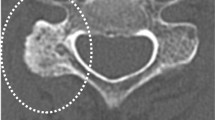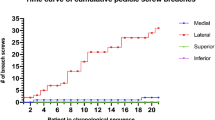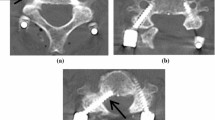Abstract
Purpose
To present the technique of free-hand subaxial cervical pedicle screw (CPS) placement without using intra-operative navigating devices, and to investigate the crucial factors for safe placement and avoidance of lateral pedicle wall perforation, by measuring and classifying perforations with postoperative computed tomography (CT) scan.
Summary of background data
The placement of CPS has generally been considered as technically demanding and associated with considerable lateral wall perforation rate. For surgeons without access to navigation systems, experience of safe free-hand technique for subaxial CPS placement is especially valuable.
Materials and methods
A total of 214 consecutive traumatic or degenerative patients with 1,024 CPS placement using the free-hand technique were enrolled. In the operative process, the lateral mass surface was decorticated. Then a small curette was used to identify the pedicle entrance by touching the cortical bone of the medial pedicle wall. It was crucial to keep the transverse angle and make appropriate adjustment with guidance of the resistance of the thick medial cortical bone. The hand drill should be redirected once soft tissue breach was palpated by a slim ball-tip prober. With proper trajectory, tapping, repeated palpation, the 26–30 mm screw could be placed. After the procedure, the transverse angle of CPS trajectory was measured, and perforation of the lateral wall was classified by CT scan: grade 1, perforation of pedicle wall by screw placement, with the external edge of screw deviating out of the lateral pedicle wall equal to or less than 2 mm and grade 2, critical perforation of pedicle wall by screw placement, large than 2 mm.
Results
A total of 129 screws (12.64 %) were demonstrated as lateral pedicle wall perforation, of which 101 screws (9.86 %) were classified as grade 1, whereas 28 screws (2.73 %) as grade 2. Among the segments involved, C3 showed an obviously higher perforating rate than other (P < 0.05). The difference between the anatomical pedicle transverse angle and the screw trajectory angle was higher in patients of grade 2 perforation than the others. In the 28 screws of grade 2 perforation verified by axial CT, 26 screws had been palpated as abnormal during operation. However, only 19 out of the 101 screws of grade 1 perforation had shown palpation alarming signs during operation. The average follow-up was 36.8 months (range 5–65 months). There was no symptom and sign of neurovascular injuries. Two screws (0.20 %) were broken, and one screw (0.10 %) loosen.
Conclusion
Placement of screw through a correct trajectory may lead to grade 1 perforation, which suggests transversal expansion and breakage of the thinner lateral cortex, probably caused by mismatching of the diameter of 3.5 mm screws and the tiny cancellous bone cavity of pedicle. Grade 1 perforation is deemed as relatively safe to the vertebral artery. Grade 2 perforation means obvious deviation of the trajectory angle of hand drill, which directly penetrates into the transverse foramen, and the risk of vertebral artery injury (VAI) or development of thrombi caused by the irregular blood flow would be much greater compared to grade 1 perforation. Moreover, there are two crucial maneuvers for increasing accuracy of screw placement: identifying the precise entry point using a curette or hand drill to touch the true entrance of the canal after decortication, and guiding CPS trajectory on axial plane by the resistant of thick medial wall.




Similar content being viewed by others
References
Kotani Y, Cunningham BW, Abumi K, McAfee PC (1994) Biomechanical analysis of cervical stabilization systems: an assessment of transpedicular screw fixation in the cervical spine. Spine 19(22):2529–2539
Jones EL, Heller JG, Silcox DH, Hutton WC (1997) Cervical pedicle screws versus lateral mass screws: anatomic feasibility and biomechanical comparison. Spine 22(9):977–982
Abumi K, Itoh H, Taneichi H, Kaneda K (1994) Transpedicular screw fixation for traumatic lesions of the middle and lower cervical spine: description of the techniques and preliminary report. J Spinal Disord 7(1):19–28
Abumi K, Ito M, Sudo H (2012) Reconstruction of the subaxial cervical spine using pedicle screw instrumentation. Spine 37(5):E349–E356
Zheng X, Chaudhari R, Wu C, Mehbod AA, Transfeldt EE (2010) Subaxial cervical pedicle screw insertion with newly defined entry point and trajectory: accuracy evaluation in cadavers. Eur Spine J 19(1):105–112
Kast E, Morh K, Richter HP, Börm W (2006) Complications of transpedicular screw fixation in the cervical spine. Eur Spine J 15(3):327–334
Gelalis ID, Paschos NK, Pakos EE, Politis AN, Arnaoutoglou CM, Karageorgos AC, Ploumis A, Xenakis TA (2012) Accuracy of pedicle screw placement- a systematic review of prospective in vivo studies comparing free hand, fluoroscopy guidance and navigation. Eur Spine J 21(2):247–255
Ishikawa Y, Kanemura T, Yoshida G, Ito Z, Muramoto A, Ohno S (2010) Clinical accuracy of three-dimensional fluoroscopy-based computer-assisted cervical pedicle screw placement: a retrospective comparative study of conventional versus computer-assisted cervical pedicle screw placement. J Neurosurg Spine 13(5):606–611
Yoshimoto H, Sato S, Hyakumachi T, Yanagibashi Y, Kanno T, Masuda T (2009) Clinical accuracy of cervical pedicle screw insertion using lateral fluoroscopy: a radiographic analysis of the learning curve. Eur Spine J 18(9):1326–1334
Lee SH, Kim KT, Abumi K, Suk KS, Lee JH, Park KJ (2012) Cervical pedicle screw placement using the “Key slot technique”.The feasibility and learning curve. J Spinal Disord Tech (Epub Ahead of Print)
Karaikovic EE, Yingsakmongkol W, Gaines RW Jr (2001) Accuracy of cervical pedicle screw placement using the funnel technique. Spine 26(22):2456–2462
Jingmign Xie, Zhang Yangjie Lu, Ning Liu Zhongliang, Yingsong Wang, Ying Zhang (2006) Transpedicular screw fixation for the lower cervical spine: anatomical measurement. J Spinal Surg 4(6):354–358 (CHN)
Zhu RF, Yang HL, Hu XY, He XS, Tang TS, Chen L, Li XG (2008) CT evaluation of cervical pedicle in a Chinese population for surgical application of transpedicular screw placement. Surg Radiol Anat 30(5):389–396
Tomasino A, Parikh K, Koller H, Zink W, Tsiouris J, Steinberger J, Hartl R (2010) The vertebral artery and the cervical pedicle: morphometric analysis of a critical neighborhood. J Neurosurg Spine 13(1):52–60
Sanelli PC, Tong S, Gonzalez G, Eskey CJ (2002) Normal variation of vertebral artery on CT angiography and its implications for diagnosis of acquired pathology. J Comput Assist Tomogr 26(3):462–470
Karaikovic EE, Kunakornsawat S, Daubs MD, Madsen TW, Gaines RW Jr (2000) Surgical anatomy of the cervical pedicles: landmarks for posterior cervical pedicle entrance localization. J Spinal Disord 13(1):63–72
Abumi K, Shono Y, Ito M, Taneichi H, Kotani Y, Kaneda K (2000) Complications of pedicle screw fixation in reconstructive surgery of the cervical spine. Spine 25(8):962–969
Richter M, Wilke HJ, Kluger P, Neller S, Claes L, Puhl W (2000) Biomechanical evaluation of a new modular rod-screw implant system for posterior instrumentation of the occipito-cervical spine: in vitro comparison with two established implant systems. Eur Spine J 9(5):417–425
Acknowledgments
The authors thank Mr. Kazuki Kawakami and Mr. Dmitri Kim for the assistance of grammatical modification in the language performance.
Conflict of interest
The authors declare that they have no conflicts of interest.
Author information
Authors and Affiliations
Corresponding author
Rights and permissions
About this article
Cite this article
Wang, Y., Xie, J., Yang, Z. et al. Computed tomography assessment of lateral pedicle wall perforation by free-hand subaxial cervical pedicle screw placement. Arch Orthop Trauma Surg 133, 901–909 (2013). https://doi.org/10.1007/s00402-013-1752-3
Received:
Published:
Issue Date:
DOI: https://doi.org/10.1007/s00402-013-1752-3




